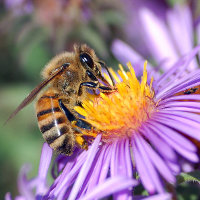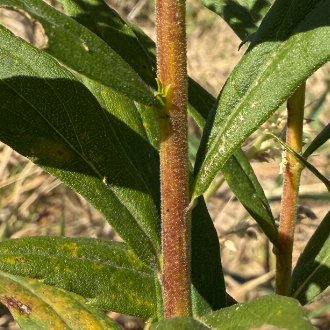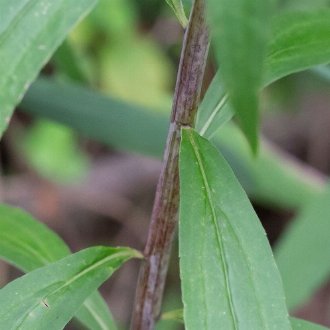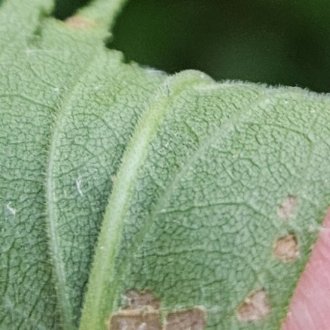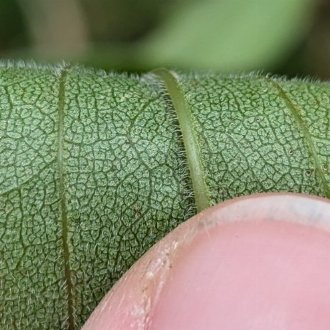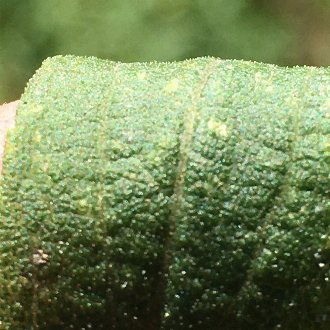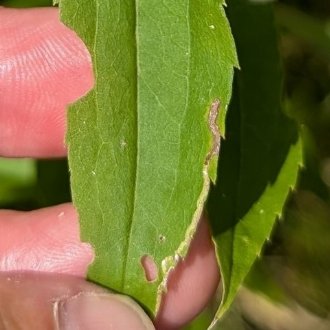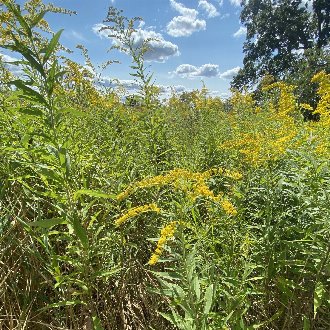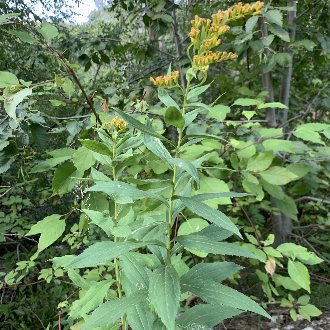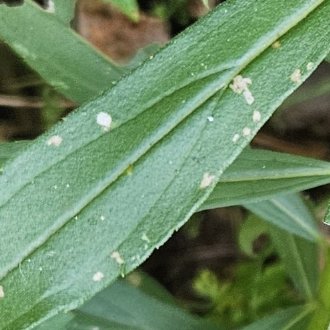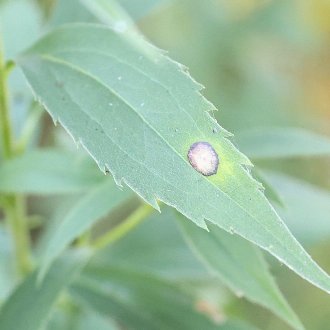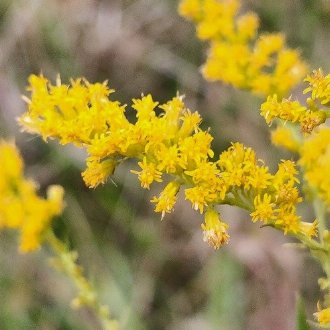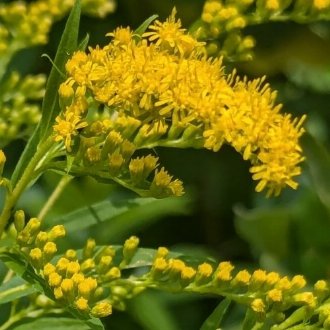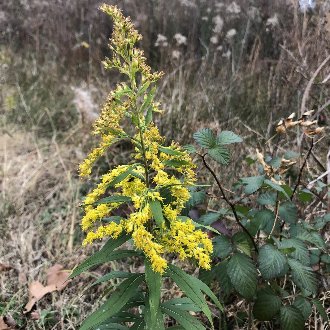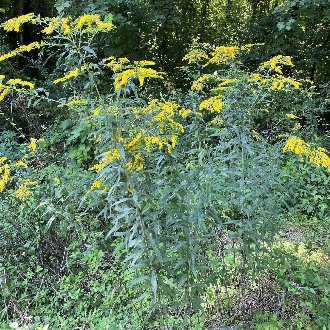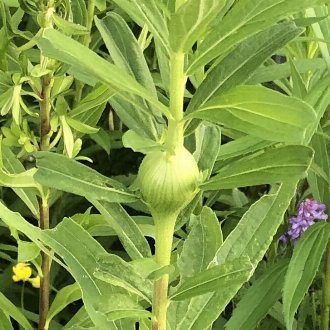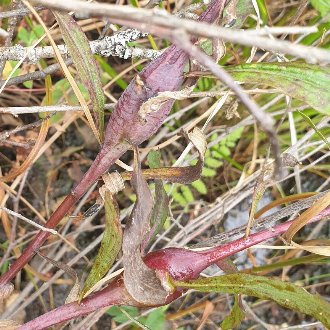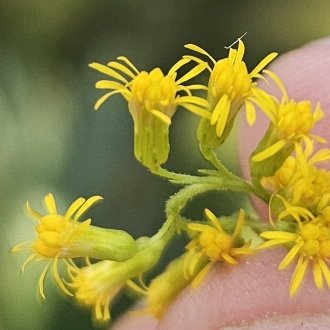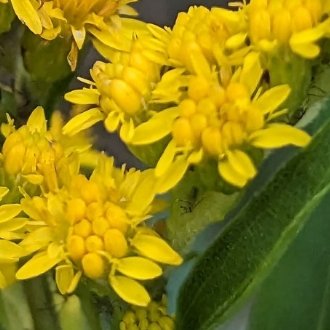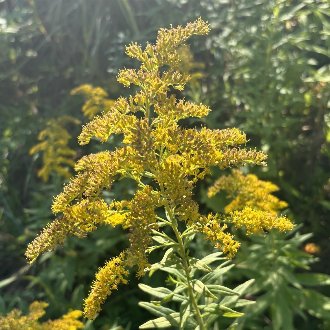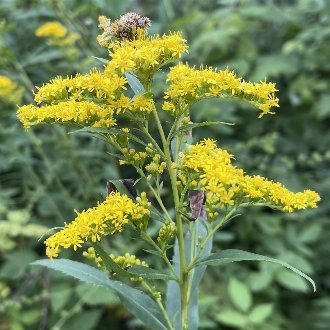Tall Goldenrod vs Giant Goldenrod
These two tall, thicket-forming goldenrods have a large range overlap and are easily confused. Both have triple-veined leaves and similar inflorescences. They are usually easily told apart by texture of the stems and leaves, and they have many other differences. Although their habitats overlap slightly, Solidago gigantea ranges farther north, is more restricted to richer, moister habitats, and is more tolerant of shade and poor drainage. Solidago altissima is more of a generalist, ranges farther south and into drier habitats, but requiring better drainage.
Tall Goldenrod (Solidago altissima) | Giant Goldenrod (Solidago gigantea) |
A common, aggressive perennial of rich, sunny, disturbed sites, native to a wide range across North America. | A large, aggressive perennial of moist, rich sites, native to a wide range in North America. |
Stem is not glaucous (waxy), and is usually covered in short hairs, especially higher up. Stem color is variable and may be green, yellowish, or reddish, but is usually not bluish. Photo © Carrie Seltzer, CC BY 4.0. | Most of the length of the stem is hairless and often (not always) glaucous, covered in a pale waxy coating. Uppermost portion of stem, in the inflorescence, can have sparse hairs. Stem color is variable but some individuals are more bluish. Photo © Bill Keim, CC BY 4.0. |
Leaf undersides are covered in fine hairs, which are denser along major veins but still present elsewhere. The greater density of hairs gives the leaf undersides a paler look at a glance. Photo © Daniel McClosky, CC BY 4.0. | Leaf undersides only have hairs along major veins, and some varieties are entirely hairless. Leaf undersides look darker green at a glance. Photo © Ryan Sorrells, CC BY 4.0. |
Tops of leaves are very scabrous (rough to the touch) and show visible hairs on close examination. Foliage usually looks slightly paler because of the hair. Photo © Becky Dill, Public Domain. | Tops of leaves are hairless and either smooth or only slightly scabrous (rough.) Foliage usually has a deeper green color. Photo © Alan Prather, CC BY 4.0. |
Found in a wider range of habitats. Usually found in sunnier habitats, and does not range as far into shade. Tolerates much drier conditions, and not as tolerant of flooding and poor drainage. Photo © botany08, CC BY 4.0. | Restricted to moister habitats. Although it can grow in full sun, it ranges farther into shade. Found in fewer habitats overall, but the more likely of the two species in floodplain forest openings and other bottomlands, especially those prone to spring flooding. Photo © Zach E Plants, CC BY 4.0. |
Serrations are variable but average subtler, and are often entirely absent on uppermost leaves. Photo © Daniel McClosky, CC BY 4.0. | Serration on leaves is variable, but leaves are always at least somewhat serrated (except possibly right under the inflorescence) and average more sharply serrated. Photo © Cole Wolf, CC BY 4.0. |
Branches are mostly, but not always perfectly secund, i.e. flowerhead arrangement averages slightly more irregular along the branches of the inflorescence, with some flowerheads pointing a bit more to the side or even slightly downward. Photo © Dominic, CC BY 4.0. | Branches of the inflorescence are more strictly secund, i.e. with flowerheads all arranged along the same side and pointing in the same direction, usually upward. Photo © Skyler Principe, CC BY 4.0. |
Blooms later on average (Usually Mid-to-Late August-November). Often is one of the last plants blooming. (Pictured plant is blooming in December in NC.) Photo © Ken Kneidel, Public Domain. | Blooms earlier on average (Usually Early Aug-Sep, often slightly earlier, rarely into October) Usually is not among the last plants blooming. (Pictured plant is from July in NC.) Photo © Becky Dill, Public Domain. |
Ball galls are relatively more common, and found throughout its range. Galls tend to be more spherical, and are more likely to occur in the top half of the plant. Photo © Andrew Sebastian, CC BY 4.0. | Ball galls are less common, and mostly restricted to the north of its range. Galls may be spherical, but average more elongated, and are more likely to be found in the bottom half of the plant. Photo © Étienne Lacroix-Carignan, Public Domain. |
Flowerheads have fewer disc florets, usually 3-6, rarely as few as 2 or as many as 9. Photo © Daniel McClosky, CC BY 4.0. | Flowerheads have more disc florets, usually 7–12, rarely as few as 4 or as many as 17. Photo © Michael Hinczewski, CC BY 4.0. |
Inflorescences tend to be larger relative to the spread of the upper leaves, denser and more regular, often taller than wide, and pyramidal, with the top branches reaching upward and/or coming to a point. Photo © Liszak Kristály, CC BY 4.0. | Inflorescences tend to be smaller relative to the spread of upper leaves, sparser, more irregular, often spreading wider than tall, and often with the topmost branches relatively horizontal. Photo © Brandon Corder, CC BY 4.0. |
Additional Notes
All of the traits mentioned in this guide are variable, with considerable overlap for some traits. It is safest to consult multiple characteristics. Of the qualities above, the texture of the stem and leaves are the most reliable for distinguishing these species.The inflorescence shape is more variable on S. altissima than on S. gigantea; one can find some individuals of S. altissima where the inflorescence is more sparse and open, and the uppermost branches are flattened to be horizontal. However, the inflorescence shape on S. gigantea is inconsistent and it rarely has a dense, pyramidal shape with upwards-pointing branches at the top the way S. altissima plants commonly do.
References & External Resources
These short lists show only links helpful for ID. For a complete list of references and resources also covering other aspects of ecology, visit the links section of the full article on each plant, which is the first entry here.

